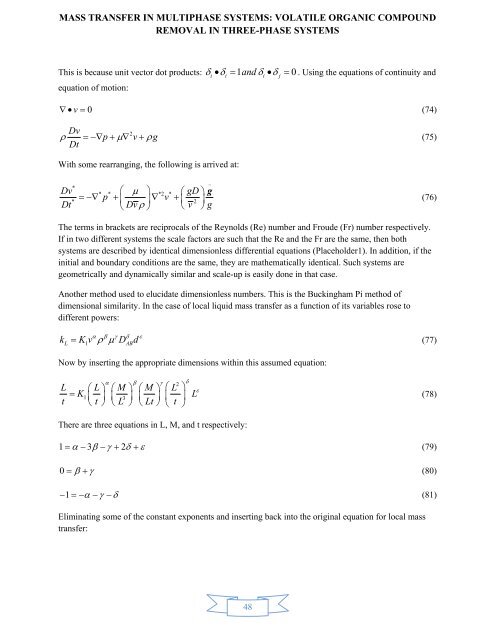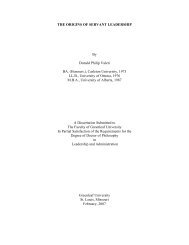mass transfer in multiphase systems - Greenleaf University
mass transfer in multiphase systems - Greenleaf University
mass transfer in multiphase systems - Greenleaf University
Create successful ePaper yourself
Turn your PDF publications into a flip-book with our unique Google optimized e-Paper software.
MASS TRANSFER IN MULTIPHASE SYSTEMS: VOLATILE ORGANIC COMPOUND<br />
REMOVAL IN THREE-PHASE SYSTEMS<br />
This is because unit vector dot products: 1 and <br />
0 . Us<strong>in</strong>g the equations of cont<strong>in</strong>uity and<br />
i i i j<br />
equation of motion:<br />
v<br />
0<br />
(74)<br />
Dv<br />
2<br />
p v g<br />
(75)<br />
Dt<br />
With some rearrang<strong>in</strong>g, the follow<strong>in</strong>g is arrived at:<br />
<br />
g<br />
*<br />
Dv * * *2 * gD <br />
p v<br />
* 2 <br />
Dt Dv v g<br />
(76)<br />
The terms <strong>in</strong> brackets are reciprocals of the Reynolds (Re) number and Froude (Fr) number respectively.<br />
If <strong>in</strong> two different <strong>systems</strong> the scale factors are such that the Re and the Fr are the same, then both<br />
<strong>systems</strong> are described by identical dimensionless differential equations (Placeholder1). In addition, if the<br />
<strong>in</strong>itial and boundary conditions are the same, they are mathematically identical. Such <strong>systems</strong> are<br />
geometrically and dynamically similar and scale-up is easily done <strong>in</strong> that case.<br />
Another method used to elucidate dimensionless numbers. This is the Buck<strong>in</strong>gham Pi method of<br />
dimensional similarity. In the case of local liquid <strong>mass</strong> <strong>transfer</strong> as a function of its variables rose to<br />
different powers:<br />
k K v D d<br />
(77)<br />
L<br />
1<br />
<br />
AB<br />
Now by <strong>in</strong>sert<strong>in</strong>g the appropriate dimensions with<strong>in</strong> this assumed equation:<br />
<br />
2<br />
L L M M L<br />
<br />
K1 3 <br />
t t L Lt t <br />
<br />
L<br />
<br />
(78)<br />
There are three equations <strong>in</strong> L, M, and t respectively:<br />
1 3 2 <br />
(79)<br />
0 <br />
(80)<br />
1 <br />
(81)<br />
Elim<strong>in</strong>at<strong>in</strong>g some of the constant exponents and <strong>in</strong>sert<strong>in</strong>g back <strong>in</strong>to the orig<strong>in</strong>al equation for local <strong>mass</strong><br />
<strong>transfer</strong>:<br />
48



